NCERT Exemplar Class 8 Science Chapter 17 Stars and the Solars System are part of NCERT Exemplar Class 8 Science. Here we have given NCERT Exemplar Class 8 Science Chapter 17 Stars and the Solars System.
NCERT Exemplar Class 8 Science Chapter 17 Stars and the Solars System
Multiple Choice Questions (MCQs)
Question1
Morning star is the name given to
(a) Pole star (b) star Sirius (c) planet Jupiter (d) planet Venus
Answer.
(d) Morning star is the name given to the planet Venus because sometimes it appears in the eastern sky before sunrise.
Question2
Which of the following figures depicts the position of Pole star correctly?
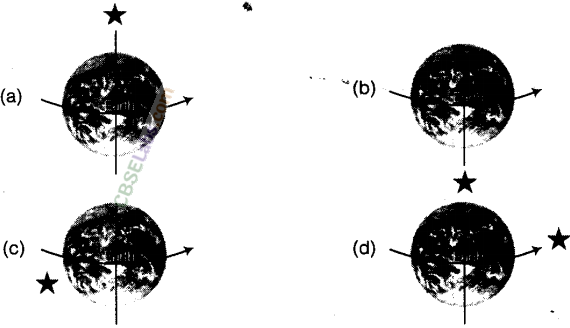
Answer.
(a) Pole star is always situated in the North direction of the earth’s axis.
Question3
The sun appears to move from east to west around the earth. This means that earth rotates from
(a) East to West (b) West to East
(c) North to South (d) West to North
Answer.
(b) The sun appears to move from East to West around the earth, it means that the earth rotates in opposite direction, i.e. from West to East.
Question4
An astronaut standing on the surface of the moon throws a ball upwards. The ball would
(a) directly fall down from the point it is released
(b) hang in space
(c) go up and then, come back to the surface of the moon
(d) keep going up never to come back
Answer.
(c) The ball will go up and then comes down because at moon, acceleration due to gravity is less than that of the earth.
Question5
Suppose a new planet is discovered between Uranus and Neptune. Its time period would be
(a) less than that of Neptune
(b) more than that pf Neptune
(c) equal to that of Neptune or Uranus
(d) less than that of Uranus
Answer.
(a) As we know that, the,time period is directly proportional to the distance from the sun, so the new planet discovered between Uranus and Neptune will have less time period than the neptune and greater than the Uranus.
Question6
The change in seasons on the earth occurs because
(a) the distance between the earth and the sun is not constant
(b) the axis of rotation of the earth is parallel to the plane of its orbit
(c) the axis of rotation of the earth is perpendicular to the plane of its orbit
(d) the axis of rotation of the earth is tilted with respect to the plane of its orbit
Answer.
(d) The axis of rotation of the earth is not perpendicular to the plane of its orbit. The tilt is responsible for the chang of seasons on earth.
Question7
The first of a month is the new moon day. On fifteenth day of the same month, which of the following figures would represent the phase of the moon?
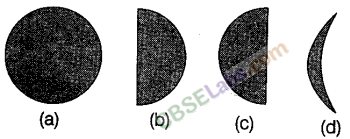
Answer.
(a) After 15 days of new moon day, there will be a full moon day and therefore, we are able to see the full moon on the fifteenth day of the same month.
Very Short Answer Type Questions
Question8
Do stars emit light only during night?
Answer.
No, stars emit light all the time. But, we are not able to see their light due to excess brightness of the Sun.
Question9
Paheli and Boojho observe a bright object in the night sky which was not twinkling. Paheli says, it is a star and Boojho says it is a planet. Who is correct?
Answer.
Boojho is correct. Only planet has the property not to twinkle, however, light due to star comes from very far distance and therefore, twinkles.
Question10
State whether the following are True/False.
(i) The planet nearest to us is Jupiter.
(ii)All the stars are at the same distance from us.
(iii)The planets do not emit light of their own.
(iv)The planets keep changing their position with respect to stars.
(v) The planet Venus appears in the eastern sky before sunrise.
(vi)The plane in which the earth revolves around the Sun is called equatorial plane of earth.
Answer.
(i) False, nearest planets to the Earth are Mars and Venus.
(ii)False, stars are at different distances from us.
(iii)True, only stars emit light of their own.
(iv)True, because the planets are always in motion.
(v) True, planet Venus is also called morning star.
(vi)False, the Earth revolves around the Sun in orbital plane.
Question11
John saw full moon on a particular day. After how many days, he will be able to see the full moon again?
Answer.
He will’be able to see full moon gpproximately after 29 days because first, the moon size will decrease to zero, i.e. new mdcn day and then will increase from the 16th day, i.e. crescent moon will appear and finally on next 15th day, there will be a full moon again.
Question12
In the picture of rotating earth given as figure mark the position of Pole star.

Answer.
Pole star is situated in the direction of earth’s axis as shown below. If does not appear to move.
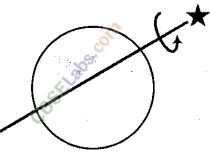
Question13
In the given figure, out of the positions A, B, C and D which will indicate
the position of the sun? Draw the sun at the appropriate position.
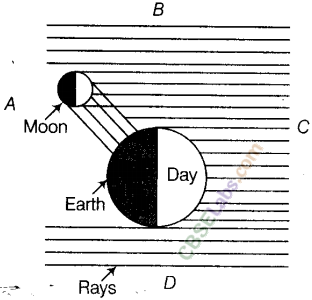
Answer.
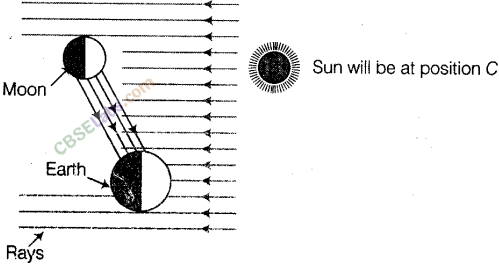
Question 14
In figure mark the arrows (<-),(->),(↓), or (↑) to show the direction of Sunlight.
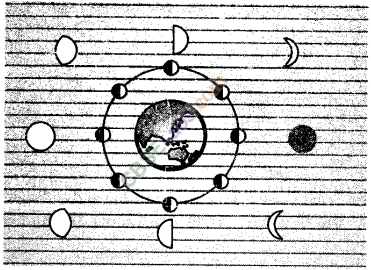
Answer.

Short Answer Type Questions
Question 15
A star is 10 light years away from the earth. Suppose it brightens up suddenly today. After how much time shall we see this change?
Answer.
As 1 light year is the distance covered by light in one year. So, if the star which is 10 light years away from the earth glows today, then it will be seen after 10 years.
Question 16
Meteors are not visible during the day time. Explain the reason.
Answer.
Meteors are very small objects which glow due to friction when they enter the earth’s atmosphere.
They are not visible during the daytime because their brightness is extremely small as compared to that of the sun.
Question 17
Why does the moon change its shape daily?
Answer.
Moon changes its shape daily because it revolves around the earth and we see only that part of the moon from which light of the sun is reflected towards us.
Question 18
Paheli saw the moon through a glass window at 8:00 pm. She marked the position of the moon on the glass pane. She got up at 4 am in the morning. Will the moon be visible at the same position?
Answer.
No, Paheli will not be able to see the position of the moon at the same place because due to revolution of the moon around the earth, the position of the moon keeps on changing during the night.
Long Answer Type Questions
Question 19
Suppose the moon emits light of its own. Would it still have phases? Justify your answer.
Answer.
No, it will not have the phases because the phases are due to the reflection of different intensities of light falling on moon from the sun due to its revolution around the Earth. Now, since the moon will have its own light, it need not to be dependent on Sun’s light to glow, so it will glow continuously and completely.
Question 20
Figure shows comets without their tail. Show the tails of the comets at positions A, B, and C. In which position will the tail be longest?
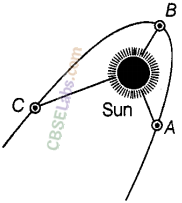
Answer.
The tail of the comet is always directed away from the Sun.
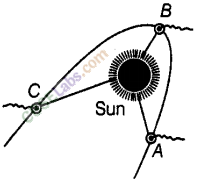
The tail will be longest in the position B because the tail is visible only when the comet passes through the inner solar system and B is the nearest point.
Question 21
Explain why we always see the same side of the moon.
Answer.
We always see the same side of the moon because the period of rotation of the moon on its axis is equal to the period of its revolution around the earth, so we only see the side that faces us and this side faces at us all the time,
Question 22
Look at the figure carefully and answer the following questions:

(a) In which part of the sky would you see the full moon in the evening?
(b) In which part of tfie sky would you see the crescent moon in the evening?
Answer.
(a) We will see the full moon on the left side (according to figure) in the evening.
(b) On the right side (lower part), we will see the crescent moon which is on the next day of the new moon day.
Question 23
Write the names of all planets in the figure.

Answer.
According to orbits (starting from the first), the names of planets are :
(i) Mercury (ii)Venus
(iii)Earth (iv) Mars
(v) Jupiter (vi) Saturn
(vii)Uranus (viii) Neptune
Question 24
Suppose the distance between the earth and sun becomes half of its present distance. What is likely to happen to life?
Answer.
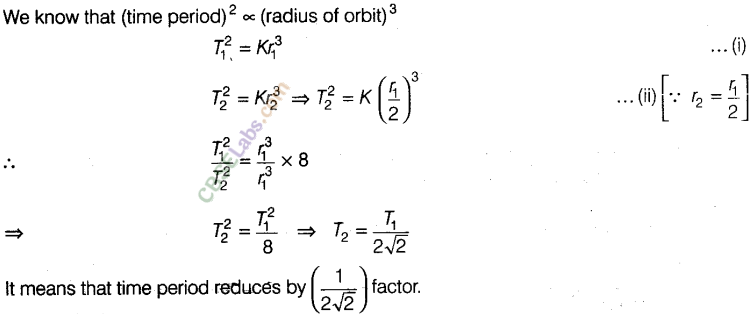
So, the days in a year will be approx. 129 instead of 365 days.
Life may no longer exist.
Question 25
Explain with a diagram how you can locate pole star with the help of the constellation Great Bear (Ursa Major).
Answer.
We can locate the pole star with the help of Ursa Major in the following way:
(i) Draw an imaginary line from the two end stars of Ursa Major.
(ii)Extend this imaginary line towards the North direction.
(iii)This line will lead to a star which is not too bright.
(iv)This is a Pole star.
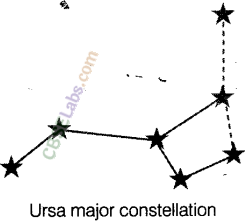
NCERT Exemplar Class 8 Science Solutions
- Chapter 1 Crop Production and Management
- Chapter 2 Microorganisms: Friend and Foe
- Chapter 3 Synthetic Fibres and Plastics
- Chapter 4 Materials : Metals and Non-Metals
- Chapter 5 Coal and Petroleum
- Chapter 6 Combustion and Flame
- Chapter 7 Conservation of Plants and Animals
- Chapter 8 Cell Structure and Functions
- Chapter 9 Reproduction in Animals
- Chapter 10 Reaching the Age of Adolescence
- Chapter 11 Force and Pressure
- Chapter 12 Friction
- Chapter 13 Sound
- Chapter 14 Chemical Effects of Electric Current
- Chapter 15 Some Natural Phenomena
- Chapter 16 Light
- Chapter 17 Stars and the Solar System
- Chapter 18 Pollution of Air and Water
NCERT Exemplar SolutionsNCERT Exemplar MathsNCERT Exemplar Science
We hope the NCERT Exemplar Class 8 Science Chapter 17 Stars and the Solars System help you. If you have any query regarding NCERT Exemplar Class 8 Science Chapter 17 Stars and the Solars System, drop a comment below and we will get back to you at the earliest.